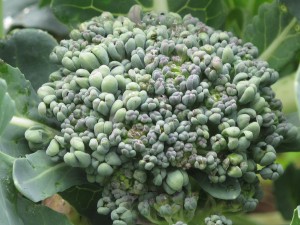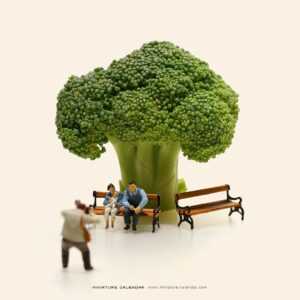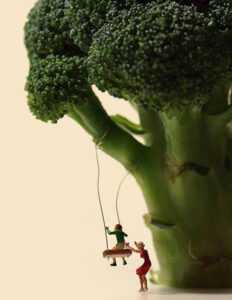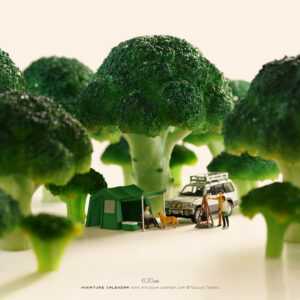Just a reminder that we now offer two brand new joyous products for you to add to your vegetable boxes: Holy Butter’s Peanut Butter and Almond Butter.
The products were one positive outcome of the Covid pandemic which led Dr. Jason Cohen of Modi’in onto a surprising journey that culminated in sweetness and health. Jason, a physician who immigrated here from the U.S., continued to maintain his practice there and regularly jet-set between the continents. When Covid brought this to a halt, Jason was left with free time and a lot of energy, but without the excellent peanut butter he used to bring back with him.
Embarking upon extensive research into mastering the roasting and grinding processes, the peanut butter maven bought a peanut roaster and began experimenting. Now that he has reached just the right flavor and consistency, Jason’s boutique peanut butter and excellent almond butter are being produced commercially at Meshek Lynn.
Holy Butter’s delectable spreads are made from top-quality local raw materials: peanuts from the Negev fields, and almonds from northern Israel’s groves. No preservatives or added ingredients – simply a butter made of the finest nuts from the finest soil or trees.
Add this new, exciting product today to your delivery via our order system.
Bon Appetit!
_____________________________________________________
It’s been a sunny, (almost) rainless week, which is just what is needed to enable the recent plentiful rains to permeate and be absorbed into the depths of the soil. It will also dry the top layers of the earth a bit so that Gabi can plow the field with his tractor and prepare the soil for the end-of-winter plants. This winter we’ve had more rain than in past years (and the coldest weather, too), which is, of course, a true blessing. But all this saturation also poses a challenge to our soil cultivation schedule. Although, like every year’s winter preparation, we cultivated the earth before the rains and even managed to work it at the season’s start when the soil was dry and the rain was quickly absorbed. But meanwhile, time has passed, more crops have been planted, others have since vacated, and once again we must prepare the earth for a new round of planting. Thus, sunny days make us happy and infused with energy!
Such an abundant, satiating winter is a great reason to clear the stage for an actual wintery vegetable that embodies within it the green explosion of a plant that absolutely LOVES rain, gray skies and most of all – cold weather:

Eat Your Broccoli…
The Battle of the Broccoli fought between mother and child has been here from time immemorial. But it’s always interesting to note that fathers, too, have paid some attention to their children’s eating habits, even in days of old. Rumor actually has it that Drusus, son of the Roman Emperor Tiberius, loved broccoli so much that he ate broccoli and only broccoli for over a month. After his urine turned green and his father scolded him, Drusus was forced to take a sad leave of absence from his favorite veggie.
Romans have always been the most loyal and ancient broccoli consumers. The vegetable’s name is derived from the Latin brachium, meaning branch or arm, which aptly describes the way broccoli flower heads branch out. Broccoli has resided in Italy from the 8th century BC, i.e. almost 3,000 years, but it actually originated in Turkey and the Eastern Mediterranean Sea region. The Etruski (an ancient nation that hailed from Asia Minor and settled in Italy) farmers in Asia Minor raised crops from the Brassica family. We have no written history about them, which is why their culture and faith remain somewhat of a mystery to this day, save for several facts like their love for the Brassica family… The Etruskis bequeathed this affinity to all the nations in the region with whom they conducted commerce: the Greeks, Phoenicians, Sicilians, Corsicans, Sardinians, and of course the Romans, who immediately fell in love with broccoli and continued to develop its family.
In Roman cuisine, broccoli was a desirable gourmet platter, otherwise known as “the five green fingers of Jupiter.” However, the early broccoli varieties were leaner, forming less of a “head.” They were also purple and turned green in cooking. Over time, the Calabrese specie was developed, sporting a larger flower head, and remaining popular and widely grown to this day.
On the European continent, broccoli proliferation took more time. Only in the 16th century did broccoli stamp its passport at the French border upon entering with the prestigious entourage of Katherina De-Medici who emigrated to France to marry His Royal Highness Henry II. Turns out the French were not impressed with the green immigrant: the esteemed chefs must have turned up their noses, exclaiming (read with a pronounced French accent): “Shame on him, that Levantine greenhorn! No class whatsoever! All those green curls out of control! Mon Dieu!!”
Broccoli is in fact a plant that arrives at the beginning of its blossom, and we essentially eat the young flower buds. If you leave the broccoli growing peacefully in the field rather than harvesting it, it’ll actually bloom. His head will spread open, and yellow and white florets will bloom from the dense green buds we eat. The flavor of these florets is sweet and spicy, but the stalks are fibrous and hardly suitable for cooking and eating. Here’s an example of a broccoli that passed its prime and is about to blossom (thank you, Chana, for all these beautiful photos):
Not all broccoli flower heads are suitable for eating. Here in the Middle East, it’s not common to eat broccoli leaves, but overseas in Italy or the Far East, for example, there are broccoli species grown for their greens, like Rapini broccoli or Chinese broccoli. Usually they are species which do not grow a dense scalp like the broccoli flower head we know, but rather bloom immediately, a gentle bloom, and their greens are harvested when they are young and tender. They are very popular additions to pasta or stir-fries. The mature broccoli greens are used in a similar way to kale. Their nutritional value is quite high, and they are rich in vitamins (A, B-complex, C) and minerals (iron and calcium). This week, indeed, some Chubeza boxes will contain broccoli greens as an alternative to kale, Swiss chard or spinach.
Meanwhile, back to our initial question: is it really so important to eat your broccoli? Once again, Mom (and maybe Dad) is right. Big time. Broccoli is rich in Vitamin A, i.e. beta carotene, evident in its strong green color, as well as folic acid, calcium (a cup of cooked broccoli is equivalent to the calcium value of half a cup of milk) iron (10% of your daily recommended consumption) absorbed in the body with the help of Vitamin C (one cup of broccoli equals one orange, Vitamin C-wise!). In addition, broccoli contains Vitamins B1, B2, B3, B6, magnesium, zinc and potassium.
But aside from its nutritional value, broccoli is gaining recognition for its important contributions to good health. For one, broccoli lowers cholesterol levels in the blood. Broccoli (as well as onion, carrot and cabbage) contains pectin fiber which binds to acids in the body, thus depositing more cholesterol in the liver and allowing less to be released into the bloodstream. Research has found that its effectiveness is equivalent to certain cholesterol-lowering medications. Broccoli is also rich in the mineral chromium which improves the function of insulin in adults who have a tendency towards type 1.5 diabetes.
And there’s more! It is common knowledge that certain members of the Cruciferae family, those responsible for the bitter flavor section of the family, are warriors in the cancer prevention battle. Recent research indicates that when chewing the plant, the Glucosinolates break down to important phytochemicals. Two have been particularly well researched: Indole and Sulforaphane. Both these compounds, which surface upon slicing, chewing or tearing apart the vegetable, have been found to delay the growth of cancerous stem cells. Their course of action is similar to other anti-cancerous components that are used clinically, by actively disturbing cell redistribution. Sulforaphane and Indole are even more prominent in broccoli sprouts. (While we’re on that subject, you can order broccoli sprouts and other excellent sprouts from Udi at Achituv via our order system).
The bitter (and spicy) characteristic of the broccoli and its relatives is also a result of the Glucosinolates, and more accurately – the mustard oil within it. These vegetables most probably developed this feature as a form of self-defense: when a harmful creature or insect attempts to assault the vegetable plant by chewing, cutting or injuring it, one taste of the sharp, piquant flavor is enough to send the aggressor fleeing. The bitter flavor can also send human beings fleeing, including many children who recoil in the face of broccoli (aside from Drusus, apparently). Fortunately, as we grow older, our taste buds develop the ability to deal with bitterness and even enjoy it (coffee, beer, broccoli…) Good thing, too, as broccoli and its family members are super vegetables that are tasty and healthy.
So as not to harm broccoli’s very valuable components, take care not to overcook. Though light cooking does have the advantage of making more broccoli segments edible, it’s best to consume your broccoli raw, steamed or very lightly cooked (3-5 minutes). Check our recipe section (in Hebrew) for excellent broccoli salads.
Hey, listen to your mother sometime.
Tips
- Broccoli fares well in the fridge. Store it there in a plastic bag to protect its nutritional value, especially the Vitamin C. Another possibility, albeit less popular, is to immerse the broccoli stalk in deep ice water (like a bouquet of flowers), covering the inflorescence with a loose plastic bag, and change the water daily.
- Do not wash the broccoli before you refrigerate. Moisture will damage it.
- When you cook/steam/lightly sauté the whole broccoli, begin with the stalks. They are harder and need more cooking time. Add the florets and leaves later (broccoli leaves are delicious and definitely worth a taste!).
- Go easy on the cooking so the broccoli remains solid and its flavor is stronger. Best to steam, not to cook.
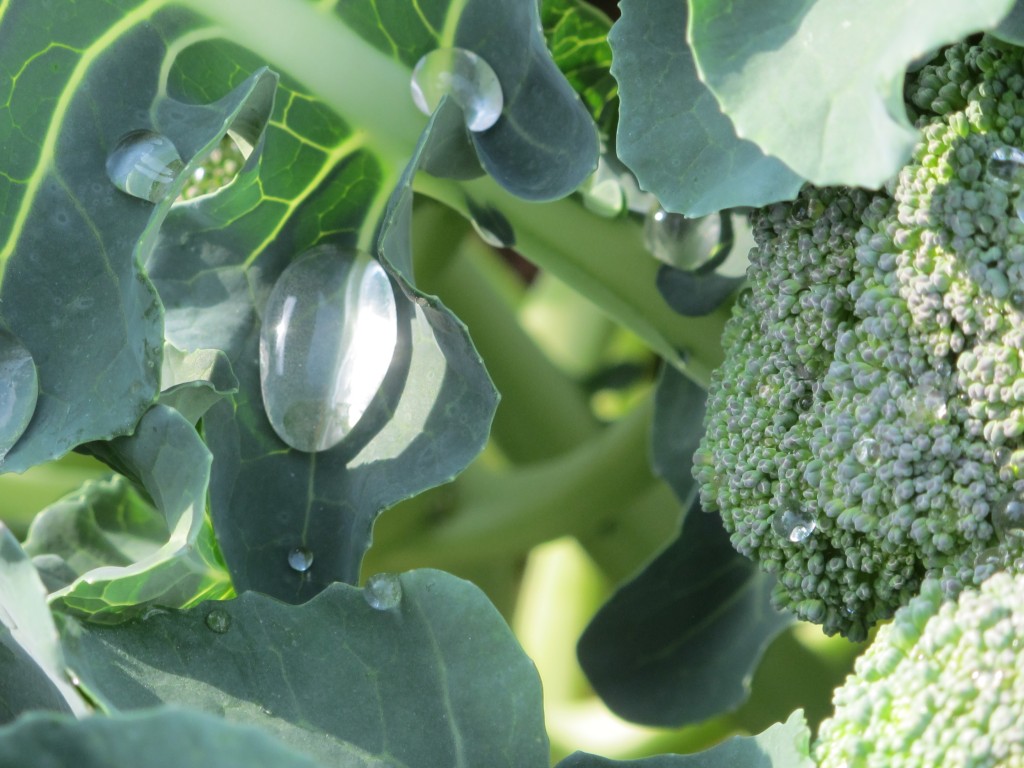
And finally, sending you a smile of admiration: Japanese artist Tanaka Tatsuya has a different way of looking at things. With imagination, creativity and humor, he creates charming lifelike scenes from daily objects, fruits and vegetables and tiny figurines. Just check out these photos. You’ll never look at broccoli quite the same way again…
Wishing everyone a nice, sunny week,
Alon, Bat Ami, Dror, Orin and the entire Chubeza team
_________________________________________________________________
WHAT’S JOINING THE BROCCOLI IN THIS WEEK’S BOXES?
For the past several weeks, the frigid cold has significant slowed down the growth of our cucumbers and tomatoes. There are now signs of a beginning to get back to business: this week we succeeded in picking cucumbers from our field and purchasing from another organic grower supplement the supply. Yet, there’s still not enough cucumbers to go around to every Chubeza box. We’ve also purchased sweet, delicious red bell peppers, while some of you will get cucumbers as well. We hope for a speedy return to our regular ongoing cucumber supply.
Monday: Potatoes, cauliflower/cabbage, Swiss chard/kale/New Zealand spinach, leeks/fresh garlic, fresh onions, broccoli, sweet red peppers, tomatoes, cucumbers/carrots, lettuce/baby greens/arugula. Small boxes only: celery/celeriac/parsley root.
Large box, in addition: Daikon/baby radishes/fennel, garden or snow peas/sweet potatoes/pumpkin, parsley/coriander, kohlrabi/turnips/ beets.
FRUIT BOXES: Red apples/pears, avocados, clementinas, red oranges/pomelit/lemons, bananas.
Wednesday: Potatoes, cauliflower, leeks/fresh garlic, fresh onions, broccoli/pumpkin, cucumbers/sweet red peppers, tomatoes, carrots/garden or snow peas/green fava beans, lettuce/baby greens, celery/celeriac/parsley root. Small boxes only: Swiss chard/kale/New Zealand spinach.
Large box, in addition: Baby radishes/beets, sweet potatoes/cabbage, parsley/coriander, kohlrabi/turnips/fennel.
FRUIT BOXES: Red apples/pears, avocados, clementinas, red oranges/oranges/pomelit, bananas/lemons.



